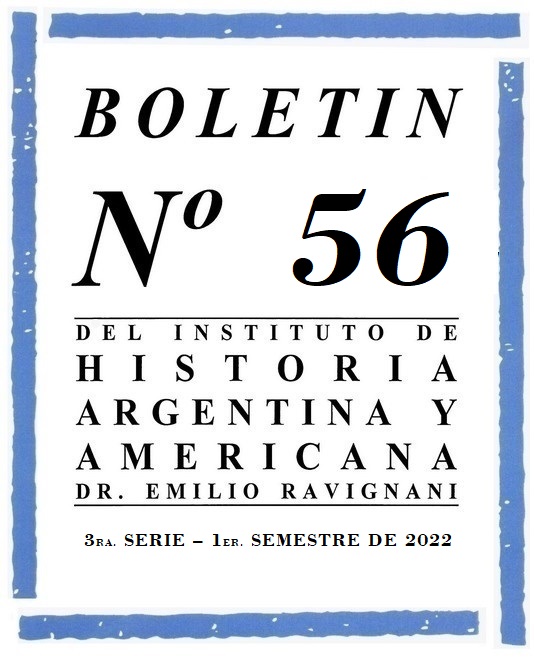Authoritarianism and entertainment in the beginnings of the nationalization of television in Argentina: Channel 7 of Buenos Aires during Onganía's presidency
Abstract
The aim of the work is to understand how the official media policy of the Onganía government prior to the Cordobazo implied a first and forceful attempt to stop the expansion of private television and the beginning of a statizing trend. The article addresses, on the one hand, the transformations in the state media structure and the subsequent administrative decisions that impacted on the state television signal; and on the other hand, the programming grid, which allows us to make inferences both regarding the social uses defined for the state signal, as well as the links established with different actors for the achievement of those uses. The work offers a new sight at the cultural policy of Onganía, revealing the government's emphasized interest in the possibilities of television in the mediation of politics. The hypothesis of the article is that the expansion of the state presence on television required considering an already consolidated field regarding its rules, actors and positions. Thus, the result was a complex experience, disputed by different groups within the State and with important conflicts and articulations with the entrepreneurship, which tried to combine authoritarian, hierarchical and paternalistic political domination with mass entertainment.Downloads
References
Bulla, G. (2009). Televisión argentina en los 60: la consolidación de un negocio de largo alcance. En G. Mastrini (Ed.), Mucho ruido y pocas leyes (pp. 117-137). Buenos Aires: La Crujía.
Druetta, S. (2012). La TV que no se ve. Villa María: Eduvim.
Durán, S. (2012). Ríe cuando todos estén tristes. El entretenimiento televisivo bajo la dictadura de Pinochet. Santiago de Chile: LOM.
García, H. R. (1993). Cien veces me quisieron matar. Buenos Aires: Planeta.
Graziano, M. (1974). Los dueños de la televisión argentina, Comunicación y Cultura, 3, pp. 175-212.
Jones, D. (1990). El despegue frustrado de la televisión argentina. Voces y culturas, 1, 57-70.
Landi, O. (1987). Medios, procesos culturales y sistemas políticos. En O. Landi (Ed.), Medios, transformación cultural y política (pp. 89-133). Buenos Aires: Legasa.
Lindenboim, F. (2020). La radio durante el primer peronismo (1943-1955). Hegemonía política, campo del espectáculo y entretenimiento de masas. Disertación doctoral, Buenos Aires, Universidad de Buenos Aires.
Luchetti, F. y Díaz Lafarga, A. (2011). Del cine a la televisión: La información audiovisual en una época de transición. En I. Marrone y M. Moyano Walker (Eds.), Disrupción social y boom documental. Argentina en los años sesenta y noventa. Buenos Aires: Biblos.
Mallimaci, F. (2015). El mito de la Argentina laica. Catolicismo, política y Estado. Buenos Aires: Capital Intelectual.
Marino, S. (2007). Del servicio al negocio. Historia de la televisión por cable en Argentina. XI Jornadas Interescuelas/Departamentos de Historia, Tucumán. http://cdsa.aacademica.org/000-108/480.pdf
Mastrini, G. (2009). El antiperonismo como factor clave de los inicios de la televisión privada argentina. En G. Mastrini (Ed.), Mucho ruido y pocas leyes. Buenos Aires: La crujía.
Mastrini, G. (2014). Las industrias culturales en Argentina. Tesis de doctorado. Madrid: Universidad Complutense de Madrid.
Mazziotti, N. (2002). La televisión en Argentina. En G. Orozco (Ed.), Historias de la televisión en América Latina (pp. 23-63). Madrid: Gedisa.
Míndez, L. (2001). Canal 7. Medio siglo perdido. Buenos Aires: Ciccus - La Crujía.
Montero Díaz, J. y Antona, T. (2018). Programación y estrategias de programación en la televisión franquista. En J. Montero Díaz (Dir.). Una televisión con dos cadenas. La programación en España (1956-1990). Madrid: Cátedra.
Morone, R. y De Charras, D. (2009). El servicio público que no fue. La televisión en el tercer gobierno peronista. En G. Mastrini (Ed.), Mucho ruido, pocas leyes (pp. 139-157). Buenos Aires: La Crujía.
Muraro, H. (1987). La comunicación masiva durante la dictadura militar y la transición democrática en la Argentina. 1973-1986. En O. Landi (Ed.), Medios, transformación cultural y política. Buenos Aires: Legasa.
Muraro, H. (2014). Neocapitalismo y comunicación de masa. Buenos Aires: Eudeba.
Portales, D. (1987). La dificultad de innovar. Santiago de Chile: Instituto Latinoamericano de Estudios Transnacionales.
O'Donnell, G. (2009). El estado burocrático autoritario. Buenos Aires: Prometeo.
Palacio, M. (2008). Historia de la televisión en España. Barcelona: Gedisa.
Paschalidis, G. (2013). Entertaining the colonels: Propaganda, social change and entertainment in Greek television fiction, 1967-74. En P. Goddard (Ed.). Popular television in authoritarian Europe. Manchester: Manchester University Press.
Pereira, A. (2012). Televisión y dictadura en el Uruguay: cambios y permanencias. Cuadernos de la Red de Historia de los medios, 2, pp. 140-179.
Petrecca, M. (2019). Sucesos entre la caída y la vuelta: sensacionalismo, política y peronismo en la revista Así el mundo en sus manos (1955-1972). Universidad de San Andrés (Tesis de maestría).
Pieranti, O. (2020). Quando o governo federal ligou a TV. Ponencia presentada en las Jornadas de Historia de los medios: televisión y dictaduras en el Cono Sur, 21-23 de octubre, Instituto Gino Germani, Universidad de Buenos Aires.
Ramírez Llorens, F. (2019). Para Onganía que lo mira por TV. el rol de la política comunicacional y la expansión de la televisión en la cobertura del Cordobazo. Revista de Historia (Comahue), 20, pp. 80-104.
Ramírez Llorens (en prensa). Medios de comunicación y utopía autoritaria: la Secretaría de Difusión y Turismo. Argentina, 1967-1969. Historia y política.
Sacramento, I. (2012). La televisión brasilera en los años de la Dictadura militar (1964-1984): la higienización del grotesco como afirmación de lo moderno. Cuadernos de la Red de Historia de los medios, 2, pp. 52-101.
Santa Cruz, E. (2012). Entre goces y llantos. La TV chilena en la dictadura (1973-1990). Cuadernos de la Red de Historia de los medios, 2, pp. 102-139.
Selser, G. (1986). El Onganiato. I La espada y el hisopo. Buenos Aires: Hyspamérica.
Sticotti, J. (2020). La televisión nacional, comienzo contingente de una experiencia perdurable: el proceso de estatización de los canales de Buenos Aires (1973-1974). Nuevo mundos mundos nuevos. Recuperado de http://journals.openedition.org/nuevomundo/79661.
Ulanovsky, C. (1976). 1951-1976. Televisión argentina 25 años después. Buenos Aires: Hachette.
Ulanovsky, C., Panno, J. J., Tijman, G. y Merkin, M. (1995). Días de Radio: Historia de la Radio Argentina. Buenos Aires: Espasa Calpe.
Ulanovsky, C., Sirvén, P. y Itkin, S. (1999). Estamos en el aire: Una historia de la televisión en la Argentina. Buenos Aires: Planeta.
Varela, M. (2005). La televisión criolla. Buenos Aires: Edhasa.
Copyright (c) 2021 Boletín del Instituto de Historia Argentina y Americana Dr. Emilio Ravignani

This work is licensed under a Creative Commons Attribution-NonCommercial 4.0 International License.
The copyright is transferred to the Boletín, but the authors may retrieve them and reproduce their work in other media or formats by means of a written request to the Editorial Committee. In such cases, the Boletín will be cited as the first publication of the work.
The works are licensed under a Creative Commons Attribution-NonCommercial 4.0 International License, which allows others to share the work with an acknowledgment of their authorship and initial publication in this journal.
Also, by written request to the Editorial Committee of the Boletín, the authors may separately establish additional agreements for the non-exclusive distribution of the version of the work published in this journal (for example, placing it in an institutional repository or publishing it in a book), with an acknowledgement of its initial publication here. No commercial uses are allowed.



















